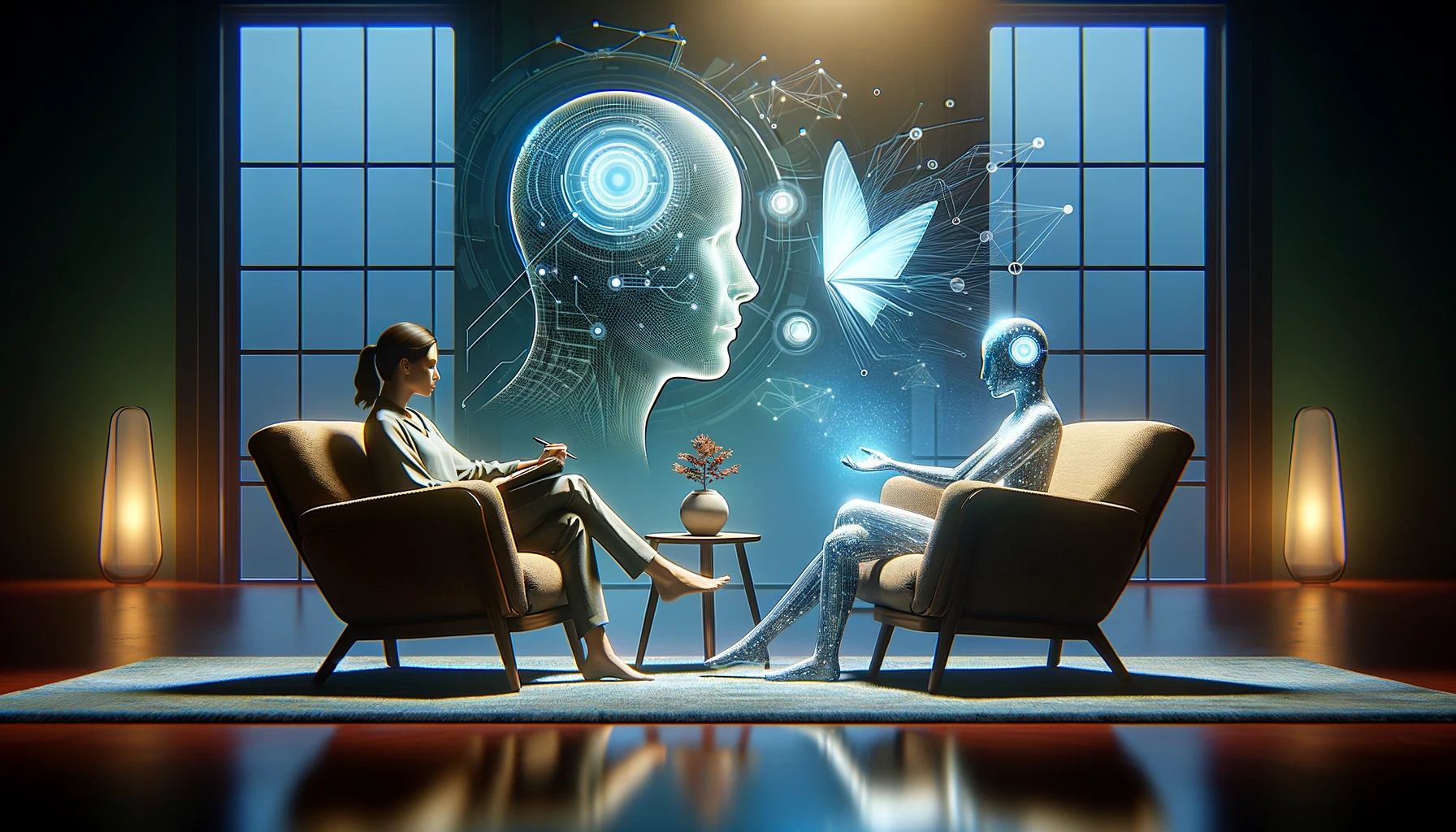15 min read
Imagine a patient like Ms. B, a middle aged woman who puts everyone’s needs before hers, so much so she nearly choked to death rather than knock on a neighbor’s door for help; a woman who can’t take good care of herself because she shuts down all of her emotional needs. Or Mr. H, trapped in cycles of compulsive shopping, impulsive unsafe sex life, and masochistic relationships, unable to feel truly desirable. These individuals, like so many in therapy, carry deeply embedded patterns— “maladaptive predictions”—that their brains developed early in life to survive emotional deprivation or trauma.
A New Therapeutic Partnership?
Traditional psychotherapy has always been the gold standard for addressing such patterns. The human therapeutic relationship provides something irreplaceable: emotional attunement, embodied presence, and the lived experience of being truly seen by another person. Yet therapy also has limitations: weekly sessions leave six days of struggle in between, therapists can only hold so much information across years of treatment, and the subjective nature of the work makes it difficult to track subtle patterns that emerge over time.
Enter artificial intelligence—not as a replacement for human therapists, but as a sophisticated collaborative tool that can enhance therapeutic outcomes in ways previously impossible. By combining the irreplaceable human elements of therapy with AI’s capacity for pattern recognition, data integration, and between-session support, we may be approaching a new paradigm in mental health treatment.
Understanding the Framework
To appreciate how AI can enhance therapy, we first need to understand what therapy is actually trying to achieve. In this case I will give example with Neuropsychoanalysis – the field I am most aligned with bridging psychoanalytic insight with neuroscience, offers a compelling framework.
Our brains are fundamentally prediction machines. From infancy, we develop unconscious models about how the world works, especially in relationships. A child whose cries bring comfort learns to predict: “When I express need, I receive care.” A child whose cries are ignored learns: “I am alone. Needing others leads to abandonment.”
These predictions become neurologically embedded through repeated experience, particularly during critical developmental periods. They operate beneath conscious awareness, shaping our emotional responses, behaviors, and relationship patterns throughout life. The brain developed these predictions for survival—they were once adaptive solutions. But they often become maladaptive when rigidly applied to all future situations.
Jaak Panksepp’s research identified seven primary emotional systems operating in mammalian brains: SEEKING (exploration, anticipation), RAGE, FEAR, LUST, CARE (nurturing), PANIC/GRIEF (separation distress), and PLAY. Early attachment experiences profoundly shape how these systems develop and interact. Secure attachment allows for flexible regulation across all systems. Disrupted attachment—through neglect, trauma, or inconsistent caregiving—can lead to chronic dysregulation.
Ms. B’s overactive PANIC/GRIEF system learned that expressing need equals abandonment, so she developed compulsive self-sufficiency. Mr. H’s violated boundaries taught him that separation equals annihilation, leading to desperate fusion with others. These aren’t conscious choices—they’re deeply embedded neural predictions that therapy must slowly update through corrective emotional experiences.
What Only Humans Can Provide…
Before exploring AI’s role, we must acknowledge what remains uniquely human in therapeutic healing.
Embodied presence and attunement: When Ms. B finally broke down and sent me a desperate voice message saying “I need your help, it’s urgent,” I didn’t provide information — I offered her immediate human presence. The therapist’s tone, pacing, emotional resonance, and willingness to adjust her schedule communicated something beyond words: “Your need matters. I am here.”
This kind of attunement cannot be algorithmic. It requires a nervous system responding to another nervous system in real time. Mirror neurons fire, emotional contagion occurs, and implicit communication happens at levels machines cannot access. The therapist feels the patient’s anxiety in her own body and modulates her responses accordingly.
Therapeutic rupture and repair: Some of the most powerful healing occurs when therapist and patient experience misattunements—moments of disconnection—and successfully repair them. This teaches the patient’s brain a new prediction: “Relationships can survive conflict. Ruptures can be mended.” AI cannot genuinely rupture or repair because it has no authentic emotional stake in the relationship.
Holding ambiguity and uncertainty: Mr. H described therapy as surgery—”I lay there, and you open my soul.” As his therapist, I resisted the pull to “seal him shut,” instead holding the tension of his fragmentation without prematurely resolving it. This capacity to sit with not-knowing, to tolerate the patient’s chaos without fixing it, is deeply human. AI, by nature, seeks patterns and solutions.
Ethical intuition in real-time: A therapist is trained to make split-second ethical judgments about how hard to push, when to interpret, when to simply express care. These decisions draw on clinical wisdom, cultural context, countertransference, and moment-to-moment assessment that no algorithm can replicate.
The transference relationship: Perhaps most fundamentally, patients project their early attachment patterns onto their therapists. These transference patterns must be experienced in relationship, interpreted, and gradually transformed through the actual relationship with a real other. AI can be a tool or supplement, but not a transference object in the transformative sense.
Where AI Enhances the Therapeutic Process
Given these irreplaceable human elements, where does AI fit? The answer lies in augmentation, not replacement—AI as the sophisticated assistant that extends the therapist’s capabilities.
Pattern Recognition Across Time
Human memory is fallible and selective. A therapist might recall that Ms. B has “issues with asking for help,” but AI can track precise patterns: she “forgets” to mention health crises in 73% of sessions; she uses the phrase “I don’t want to be a burden” an average of 2.3 times per session; her forgetting increases by 40% in the week following visits with her parents.
These patterns, visible when data is aggregated, can help therapists form hypotheses: “Notice how you ‘forgot’ to take your pain medication the week after seeing your parents. What might that tell us about what gets activated in those visits?”
For someone like Mr. H, AI could map the relationship between his credit card spending, sexual activity, and periods when he hasn’t contacted his therapist—revealing how his SEEKING system activates when his PANIC/GRIEF system feels uncontained. The therapist gains a more three-dimensional view of the patient’s unconscious patterns.
Between-Session Support and Homework
The weekly 50-minute session has always been therapy’s constraint. What happens during the rest of the week?
AI can provide structured between-session support that reinforces therapeutic work without replacing the human relationship. When Ms. B feels the urge to skip asking for help with something, she could interact with an AI tool that asks: “What are you predicting will happen if you ask? Where in your body do you feel that prediction? What’s one small experiment you could try?”
For Mr. H, when the “lizard” of desire starts crawling and he feels the urge to compulsively shop or seek sexual encounters, an AI companion might prompt: “You’re experiencing strong SEEKING activation. Can you pause for three minutes? What feeling might you be moving away from right now?”
These aren’t therapy sessions—they’re extensions of therapeutic learning, helping patients apply insights in real-time. The AI reinforces the therapist’s interpretations and interventions, providing scaffolding between sessions.
Psychoeducation Tailored to the Individual
Both Ms. B and Mr. H would benefit from understanding how their attachment systems work, but generic psychoeducation often doesn’t stick. AI can provide personalized, bite-sized learning matched to where the patient is in treatment.
When Ms. B begins recognizing her anxiety, an AI tool could offer a three-minute explanation of how her PANIC/GRIEF system learned to stay activated through distraction, using her own examples from therapy. When Mr. H struggles with his overwhelming feelings, AI could help him understand the neuroscience of dissociation and body hatred, presented through the lens of his specific history.
This reinforces therapeutic work by meeting patients where they are, when they’re ready, in language calibrated to their understanding.
Tracking Therapeutic Progress and Outcomes
How do we know if therapy is working? Traditional measures—subjective report, therapist observation—are valuable but incomplete. AI can track linguistic patterns, emotional tone, behavioral changes, and symptom fluctuation across time with precision humans cannot match.
Is Ms. B actually asking for help more frequently? AI analysis of session transcripts could objectively measure this. Is Mr. H’s affect less labile? AI could track emotional volatility across sessions. Are the maladaptive predictions updating? AI could identify when patients spontaneously challenge their own predictions rather than waiting for therapist interpretation.
This data serves the therapeutic dyad—giving both patient and therapist concrete evidence of change, or lack thereof, informing adjustments to treatment.
A Practical Integration Model
What might optimal integration actually look like?
Before therapy begins: AI-assisted assessment helps identify patterns in intake materials, flags potential diagnoses, suggests evidence-based approaches, and predicts which therapeutic modalities might suit this patient.
During active treatment:
- Weekly (bi-weekly or monthly) sessions remain human-led, with the therapist providing attunement, interpretation, and relationship;
- Between sessions, patients use AI tools for homework, skills practice, journaling prompts, and crisis stabilization;
- AI tracks patterns across sessions, alerting therapist to important themes or changes;
- Therapist reviews AI summaries and analytics to enhance case formulation.
In crisis moments: When Ms. B is avoiding asking for help or Mr. H is spiraling into panic, an AI tool provides immediate stabilization techniques while encouraging appropriate human help-seeking. It cannot replace emergency services, but it can bridge the gap and reduce isolation.
For integration and termination: AI helps patients consolidate learning—”Let’s review the three major predictions we’ve updated during our work together”—and provides ongoing support after termination, helping maintain gains without fostering dependency.
Ethical Considerations and Boundaries
This integration raises important concerns that must be addressed:
Privacy and data security: Therapeutic content is deeply private. AI systems must meet the highest standards of encryption, data protection, and ethical use. Patients must give fully informed consent about how their data is used.
Dependency and attachment: There’s risk that patients might become attached to AI in ways that impede real-world connection. The AI must be explicitly framed as a tool, not a relationship, with clear boundaries about its limitations.
Algorithmic bias: AI systems can perpetuate biases in their training data. Special care is needed to ensure AI tools don’t reinforce cultural assumptions, pathologize normal variation, or fail to account for diverse experiences. I am afraid that we have evidence that this is not yet the case.
The therapeutic frame: Therapy requires clear boundaries. AI tools must enhance rather than blur these boundaries. They should reinforce the therapist’s care and the primacy of the therapeutic relationship, not create parallel or competing sources of interpretation.
Human judgment: AI should inform, never dictate, clinical decisions. The therapist remains responsible for case formulation, treatment planning, and interventions. AI is consultative, not prescriptive.
Synergy, Not Substitution
The future of therapy isn’t human versus machine. It’s human wisdom enhanced by machine capabilities—the irreplaceable art of healing informed by the precision of technology. It’s the therapist’s attuned presence extended through time and space by tools that support therapeutic work without replacing its essential human heart.
In this synergy lies not just improved efficiency, but the possibility of reaching more people, providing better support between sessions, catching deterioration earlier, and helping both patients and therapists see patterns that might otherwise remain invisible. The goal remains unchanged: to help people update their maladaptive predictions, regulate their emotional systems, and discover that they are worthy of connection, capable of change, and fundamentally, beautifully human.
Do you want to chat about this article? Leave a comment below or send me an email with your thoughts and don’t forget to like us on Facebook.
